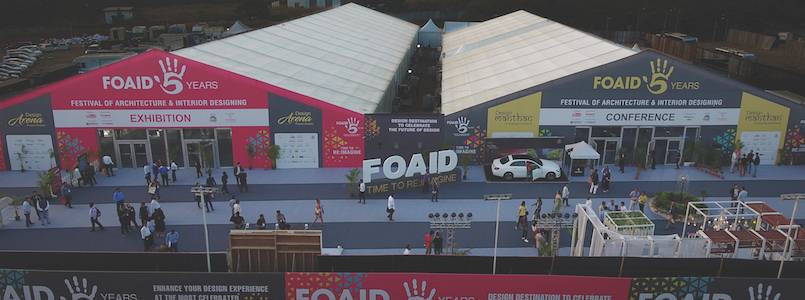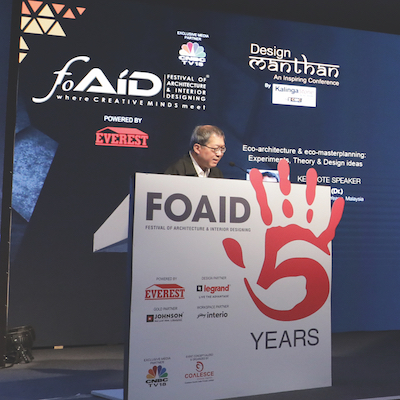1st Quarter 2019
Festival of Architecture and Interior Designing (FOAID)
April 29, 2019
The Mumbai edition of the Festival of Architecture and Interior Designing (FOAID) was held on 8th and 9th December, 2018. Conceived as a networking platform for design and architecture professionals, FOAID moved away from the stereotypical mould of architectural conferences and events in India by inviting the state President of ruling party as the chief guest on the opening day of the event. Though the chief guest had little to speak, it was refreshing to see to the architectural community attempting to include a political representative into an otherwise exclusive event, meant only for the architectural and design fraternity.

The two-day FOAID event was grand in scale and exclusive in its content. The venue was in BKC grounds, which is surrounded by huge commercial offices and skyscrapers, that together make it one of the biggest financial hubs of the country. The choice of the venue and the targeted audience—which saw architects, interior designers and decorators, material manufacturers and suppliers, and a huge participation from the student community—reaffirmed the exclusive nature of the event. The conference organised keynote addresses, presentations, panel discussions and competitions during two days. A range of panel discussions were devised around the theme, Time to Re:Imagine. The discussions and presentations were mostly formulaic conversations and did not try to push the envelope of the discourse around architecture in any way. One of the panel discussions, titled #feestoo, was organised on the second day of the event where seven male architects sat on the stage to discuss remuneration of architects in the industry. What came as a disappointment was the fact that the panel discussion was introduced with the reference to the #metoo movement that gave a voice to multiple women who came out with their harassment and abuse stories last year in India. To use a reference to such a powerful movement and then appropriate it to talk about remuneration is not only insensitive but also a huge loss of opportunity. What could have become a platform to address the issues of harassment and abuse within the architectural fraternity ended up becoming just a gimmicky reference.
The event truly succeeded in providing a networking platform for the architecture and design industry through its post-event dinner, exhibition of more than 250 built and unbuilt projects, and different design competitions for both the students and professionals. Compared to the Delhi event, which happened in September 2018 and had a strong presence of architects practicing sustainable and appropriate architecture, the Mumbai event was focussed more on commercial practices and also had a lack of women representation amongst architects, with more than three panel discussions that took place without any female architects on stage. This was surprising and disappointing because Mumbai is home to some of the most successful female women-led architectural studios in the country.
The organisers chose two architects, Mustapha Khalid Palash from Vistaara Architects, Bangladesh and Dr. Ken Yeang, from T.R. Hamzah & Yeang, Malaysia, to give key note addresses. Mustapha Khalid presented on Aroma of Concrete, detailing his journey in the evolution of his use of concrete. Describing it as an “enigmatic substance”, he touched upon reasons for his love of concrete, evident in his design style—a blend of modernism, brutalism, romanticism and minimalism. On the other hand, Dr. Ken Yeang spoke on Eco architecture & eco- masterplanning: Experiments, Theory & Design Ideas, where he talked about how saving Earth has become a necessity at present. Citing the biotic and abiotic constituents of our planet, he explained the most ideal Pattern of Physical Integration—continuous corridors and fingers with ecological spaces interspersed across the city through vertical and horizontal connections seamlessly bound together. He talked about how, by emulating and replicating ecosystem attributes, we can integrate ecological design with key infrastructure. Whether it was a conscious choice or not to have these two different schools of thought for keynote addresses, it would have been interesting to have the two architects discuss their approaches together on the same stage.
At the end of the two days, the organisers had already announced the dates for the 2019 events to be held again in Delhi and Mumbai at the end of the year. The upcoming events will be bigger and grander in scale, as promised by the organisers. However, if FOAID wants to truly rise above than just being a networking platform, it needs to have content that moves beyond the usual. It needs to facilitate uncomfortable conversations, which the architectural fraternity shies away from. With its network of architects, designers and schools of architecture, FOAID has the potential to be an engaging and thoughtful platform, but for that, it would need to move away from being a self-congratulatory echo-chamber for architects and interior designers. We have a number of those already.
To read the complete article, get your hardcopy at our online shop/newsstands/major bookstores; subscribe to FuturArc or download the FuturArc App to read the issues!
Previously Published Happening
Contact us at https://www.futurarc.com/contact-us for older articles.


